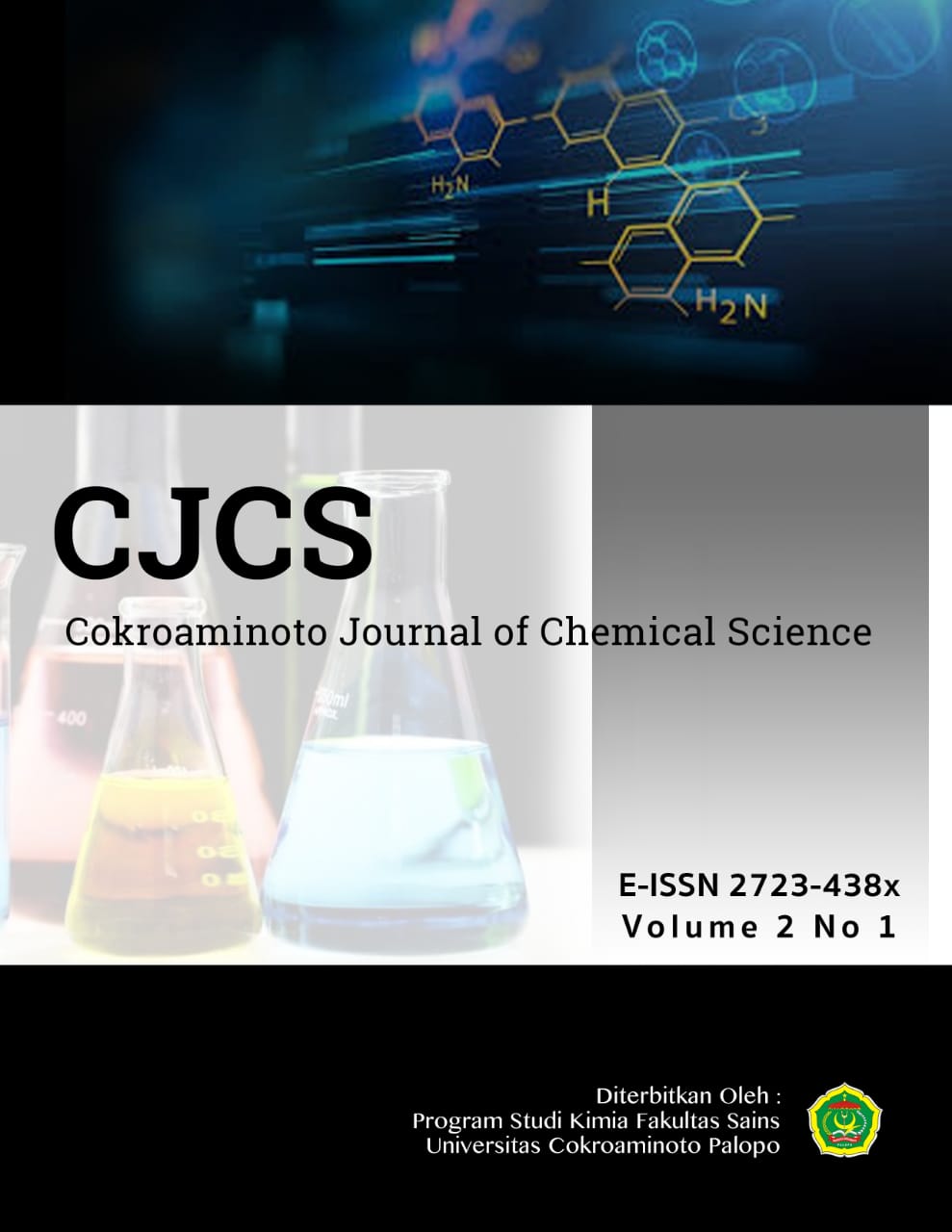ANALISIS KOMPONEN KIMIA DAN UJI AKTIVITAS ANTIOKSIDAN EKSTRAK RIMPANG JAHE MERAH (Zingiber officinale Rosc. Var rubrum)
Keywords:
Rhizome, Red Ginger, Zingiber officinale Rosc. Var rubrum, Antioksidant, DPPHAbstract
Study on chemical component analysis and antioxidant activity test of red ginger rhizome extract (Zingiber officinale Rosc. Var rubrum) has been conducted. The red ginger rhizome was extracted by maceration method and using methanol as a solvent. The antioxidant activity was tested by using DPPH method with wavelength 515 nm. The result showed that positively, red ginger rhizome extract containing flavonoid, tannins, saponins, alkaloids and terpenoids compounds, whereas, the antioxidant antioxidant anticity test got value IC50 10, 35µg/mL classified as very strong.
Downloads
Download data is not yet available.
References
[1] Nugroho, Ignatius, A, Lokakarya Nasional Tanaman Obat Indonesia. Apforgen News Letter Edisi 2, 2010.
[2] Kamaranian, R., Fatemeh, G., “Screening of totalphenol and flavonoid content, antioxidant and antibacterial activities of the methanolic extracts of three silene species from Iran” , International Journal of Agriculture and Crop sciences, Hal. 308-310, 2013.
[3] World Health Organization. 2001. General Guideliner for Metnhodologies on Research and Evaluation of Traditional Medicine. WHO, Geneva, Switzerland
[4] Ongkar, P., Jitendra, B., and Revan, K., “Evalution of Antioxidant activity of traditional formulation Giloy satca and Hydroalcoholic extract of the Curculigo orchioides Gaerth”, Journal of Applied Pharmaceutical Science, Hal. 209-213, 2012.
[5] Nishantini, A., A. Agnel, R, V.R. Mohan, “Total Phenolic, Flavonoid Content and In Vitro Antioxidant Activity of Leaf of Suaeda monoica Forssk ex. Gmel (Chenopodiaceae)’, International Journal of Advamced Life Sciences, Hal. 35-38, 2012.
[6] Tim Bina Karya Tani, Budidaya Tanaman Jahe. Yrama Widya, Bandung, 2008.
[7 Rahminiwati, M., Aulia, A.M.P., Sitti, S., Andriyanto, Soeripto, Unang, P., ”Bioprospeksi ekstrak jahe gajah sebagai anti-Crd: Kajian aktivitas antibakteri terhadap Mycoplasma galliseptikum dan E.Coli in vitro”, Jurnal llmu Pertanian Indonesia, Vol.15.(1) hlm. 7-13, 2010.
[8] Zakaria, F.R., Jahe Berpotensi Mencegah Infeksi Virus, Kompas, 2005.
[9] Nursal, W., Sridan WIlda, S, Bioaktifitas ekstrak jahe (Zingiber officinale Roxb.) dalam menghambat pertumbuhan koloni bakteri Escherichia coli dan Bacillus subtilis, Jurnal Biogenesis, 2(2): 64-66, 2006.
[10] Molyneux, P., “The Use of the stable Free Radical Dipheneylpicrylhidrazyl (DPPH) for Estimating Antioxidant Activity”, Journal of Sciences and Tecnology, Songklanakarin J. Sci.Technol Vol 26, Hal:211-219, 2004.
[2] Kamaranian, R., Fatemeh, G., “Screening of totalphenol and flavonoid content, antioxidant and antibacterial activities of the methanolic extracts of three silene species from Iran” , International Journal of Agriculture and Crop sciences, Hal. 308-310, 2013.
[3] World Health Organization. 2001. General Guideliner for Metnhodologies on Research and Evaluation of Traditional Medicine. WHO, Geneva, Switzerland
[4] Ongkar, P., Jitendra, B., and Revan, K., “Evalution of Antioxidant activity of traditional formulation Giloy satca and Hydroalcoholic extract of the Curculigo orchioides Gaerth”, Journal of Applied Pharmaceutical Science, Hal. 209-213, 2012.
[5] Nishantini, A., A. Agnel, R, V.R. Mohan, “Total Phenolic, Flavonoid Content and In Vitro Antioxidant Activity of Leaf of Suaeda monoica Forssk ex. Gmel (Chenopodiaceae)’, International Journal of Advamced Life Sciences, Hal. 35-38, 2012.
[6] Tim Bina Karya Tani, Budidaya Tanaman Jahe. Yrama Widya, Bandung, 2008.
[7 Rahminiwati, M., Aulia, A.M.P., Sitti, S., Andriyanto, Soeripto, Unang, P., ”Bioprospeksi ekstrak jahe gajah sebagai anti-Crd: Kajian aktivitas antibakteri terhadap Mycoplasma galliseptikum dan E.Coli in vitro”, Jurnal llmu Pertanian Indonesia, Vol.15.(1) hlm. 7-13, 2010.
[8] Zakaria, F.R., Jahe Berpotensi Mencegah Infeksi Virus, Kompas, 2005.
[9] Nursal, W., Sridan WIlda, S, Bioaktifitas ekstrak jahe (Zingiber officinale Roxb.) dalam menghambat pertumbuhan koloni bakteri Escherichia coli dan Bacillus subtilis, Jurnal Biogenesis, 2(2): 64-66, 2006.
[10] Molyneux, P., “The Use of the stable Free Radical Dipheneylpicrylhidrazyl (DPPH) for Estimating Antioxidant Activity”, Journal of Sciences and Tecnology, Songklanakarin J. Sci.Technol Vol 26, Hal:211-219, 2004.
Downloads
Published
2020-10-08
How to Cite
[1]
R. Munadi, “ANALISIS KOMPONEN KIMIA DAN UJI AKTIVITAS ANTIOKSIDAN EKSTRAK RIMPANG JAHE MERAH (Zingiber officinale Rosc. Var rubrum)”, CJCS, vol. 2, no. 1, pp. 1–6, Oct. 2020.
Issue
Section
Articles
License
In submitting the manuscript to the journal, the authors certify that:
- They are authorized by their co-authors to enter into these arrangements.
- The work described has not been formally published before, except in the form of an abstract or as part of a published lecture, review, thesis, or overlay journal.
- That it is not under consideration for publication elsewhere,
- That its publication has been approved by all the author(s) and by the responsible authorities – tacitly or explicitly – of the institutes where the work has been carried out.
- They secure the right to reproduce any material that has already been published or copyrighted elsewhere.
- They agree to the following license and copyright agreement.
License and Copyright Agreement
Authors who publish with this journal agree to the following terms:
- Authors retain copyright and grant the journal right of first publication with the work simultaneously licensed under Creative Commons Attribution License (CC BY 4.0) that allows others to share the work with an acknowledgment of the work's authorship and initial publication in this journal.
- Authors are able to enter into separate, additional contractual arrangements for the non-exclusive distribution of the journal's published version of the work (e.g., post it to an institutional repository or publish it in a book), with an acknowledgment of its initial publication in this journal.
- Authors are permitted and encouraged to post their work online (e.g., in institutional repositories or on their website) prior to and during the submission process, as it can lead to productive exchanges, as well as earlier and greater citation of published work.

